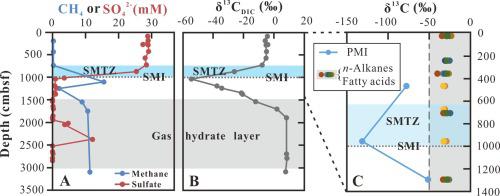当前位置:
X-MOL 学术
›
J. Asian Earth Sci.
›
论文详情
Our official English website, www.x-mol.net, welcomes your feedback! (Note: you will need to create a separate account there.)
Porewater geochemical and lipid biomarker signatures for anaerobic methane oxidation in the hydrate-bearing system from the Taixinan Basin, the South China Sea
Journal of Asian Earth Sciences ( IF 3 ) Pub Date : 2020-11-01 , DOI: 10.1016/j.jseaes.2020.104559 Yan Li , Qian-Zhi Zhou , Xiang-Po Xu , Jin-Zhong Liu , Guo-Yi Zhou , Yun-Xin Fang , Jiang-Hai Wang
Journal of Asian Earth Sciences ( IF 3 ) Pub Date : 2020-11-01 , DOI: 10.1016/j.jseaes.2020.104559 Yan Li , Qian-Zhi Zhou , Xiang-Po Xu , Jin-Zhong Liu , Guo-Yi Zhou , Yun-Xin Fang , Jiang-Hai Wang

|
Abstract Anaerobic oxidation of methane (AOM) is one of the most important biogeochemical processes associated with hydrate dissociation and carbon cycling. Though AOM has been extensively investigated, the variations of its microorganisms and lipid biomarkers are still not fully understood. In this study, the porewater geochemical and lipid biomarker evidence for AOM was systematically investigated in the hydrate-bearing system from the Taixinan Basin, the South China Sea, aiming to better expound the vertical variations of AOM-related biomarker signatures and causes of the weak lipid biomarker patterns. Accordingly, the sulfate-methane interface (SMI) depth of 1,000 cmbsf and onset of AOM were determined on the basis of the vertical profiles of porewater parameters. The occurrence of 13C-depleted 2,6,10,15,19-pentamethylicosane (PMI) with the δ13C ratios of −77.7‰ to −131.4‰ near the SMI are in accord with the porewater parameters, despite the absence of archaeol and sn2-hydroxyarchaeol and low abundances of PMI. Meanwhile, the strongly 13C-enriched iso-C15:0 and anteiso-C15:0 fatty acids suggest that non-methane hydrocarbons or oil derivatives are speculated as the probable carbon sources for sulfate-reducing bacteria due to the presence of unresolved complex mixtures (UCMs) and odd–even predominance (OEP) values (about 1.0). The weak in situ signal of AOM-related biomarkers may be attributed to the low-flux methane supply, and dilution effect from the high input of allochthonous and autochthonous organic matters. The great difference in biomarkers between the Taixinan Basin and previously reported sites should be further clarified on the basis of more extensive studies in various AOM-related settings.
中文翻译:

南海台西南盆地含水合物系统中厌氧甲烷氧化的孔隙水地球化学和脂质生物标志物特征
摘要 甲烷厌氧氧化(AOM)是与水合物分解和碳循环相关的最重要的生物地球化学过程之一。尽管 AOM 已被广泛研究,但其微生物和脂质生物标志物的变化仍未完全了解。本研究在南海台西南盆地含水合物系统中系统地研究了 AOM 的孔隙水地球化学和脂质生物标志物证据,旨在更好地阐述 AOM 相关生物标志物特征的垂直变化以及弱水合物的成因。脂质生物标志物模式。因此,基于孔隙水参数的垂直剖面确定了 1,000 cmbsf 的硫酸盐 - 甲烷界面 (SMI) 深度和 AOM 的开始。13C耗尽的2、6、10、15的出现,19-五甲基二十烷 (PMI) 在 SMI 附近具有 -77.7‰ 至 -131.4‰ 的 δ13C 比率与孔隙水参数一致,尽管不存在古菌和 sn2-羟基古菌并且 PMI 丰度低。同时,富含 13C 的异 C15:0 和反异 C15:0 脂肪酸表明,由于存在未解析的复杂混合物,推测非甲烷烃或油衍生物是硫酸盐还原菌可能的碳源。 UCM) 和奇偶优势 (OEP) 值(约 1.0)。AOM 相关生物标志物的弱原位信号可能归因于低通量的甲烷供应,以及来自外来和本土有机物的高输入的稀释效应。
更新日期:2020-11-01
中文翻译:

南海台西南盆地含水合物系统中厌氧甲烷氧化的孔隙水地球化学和脂质生物标志物特征
摘要 甲烷厌氧氧化(AOM)是与水合物分解和碳循环相关的最重要的生物地球化学过程之一。尽管 AOM 已被广泛研究,但其微生物和脂质生物标志物的变化仍未完全了解。本研究在南海台西南盆地含水合物系统中系统地研究了 AOM 的孔隙水地球化学和脂质生物标志物证据,旨在更好地阐述 AOM 相关生物标志物特征的垂直变化以及弱水合物的成因。脂质生物标志物模式。因此,基于孔隙水参数的垂直剖面确定了 1,000 cmbsf 的硫酸盐 - 甲烷界面 (SMI) 深度和 AOM 的开始。13C耗尽的2、6、10、15的出现,19-五甲基二十烷 (PMI) 在 SMI 附近具有 -77.7‰ 至 -131.4‰ 的 δ13C 比率与孔隙水参数一致,尽管不存在古菌和 sn2-羟基古菌并且 PMI 丰度低。同时,富含 13C 的异 C15:0 和反异 C15:0 脂肪酸表明,由于存在未解析的复杂混合物,推测非甲烷烃或油衍生物是硫酸盐还原菌可能的碳源。 UCM) 和奇偶优势 (OEP) 值(约 1.0)。AOM 相关生物标志物的弱原位信号可能归因于低通量的甲烷供应,以及来自外来和本土有机物的高输入的稀释效应。


























 京公网安备 11010802027423号
京公网安备 11010802027423号